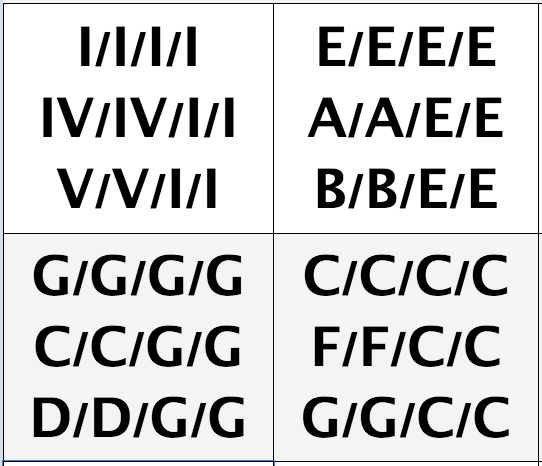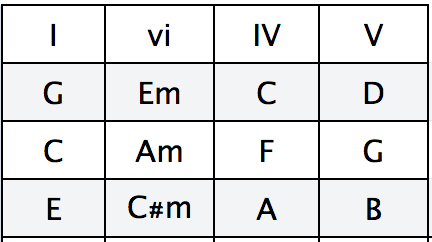5 Most Popular And Common Guitar Chord Progressions For Song Writers
Author: Mike Shear

 While you can learn and practice every possible guitar chord countless times in the Uberchord app (click here for free download, or if you still have not checked it out!), the aim of this article is to fill in your repertoire faster than I can fill in a page.
While you can learn and practice every possible guitar chord countless times in the Uberchord app (click here for free download, or if you still have not checked it out!), the aim of this article is to fill in your repertoire faster than I can fill in a page.
That being said, I’m starting in the last place beginner guitarists want to find themselves, in the middle of music theory class. Quick and painless, chord nomenclature, going through a scale, major chords are written with a major roman numeral, minor with lower case.
7th’s are written with a superscript 7 written on the right of the numeral, diminished chords with a superscript theta to the right of the numeral (ø).
So, without going into too much detail about the why, a major scale (I’ll use the keys of G and C as my samples) in chords are written as such:

If you would like a more in depth look at the theory behind scales and chord building, Uberchord has previously written a full Beginner’s music theory 101 courses here:
Table of Contents
Beginner’s Guide To Music Theory – Part 1: The Major Scale Guitar
Beginner’s Guide to Music Theory – Part 2: Music Intervals
Beginner’s Guide to Music Theory – Part 3: Chords
Beginner’s Guide to Music Theory – Part 4: The Circle of Fifths
Beginner’s Guide to Music Theory – Part 5: Music Modes
Beginner’s Guide to Music Theory – Part 6: Chord Inversions
Beginner’s Guide to Music Theory – Part 7: Chord Progressions vol. 1
Beginner’s Guide To Music Theory – Part 8: Chord Progressions Vol. 2
Beginner’s Guide To Music Theory – Part 9: Chord Progressions in Minor Keys
I’ll be referring to information in these articles throughout this article. I encourage all players to start learning theory, it’s a pathway to understanding and breaking down what and how your favorite players are doing. You’ll notice that there are two chords that are used in each of the progressions below, the I, also known as the tonic, and the V, known as the dominant. The tonic is the tonal center of the scale, it defines the key of the song. The dominant contains the tonal implication of the key as well, by containing two notes that are a tonne (one a ½ step, one a whole) lower than the two notes of the tonic, and a single note that is shared in the tonic chord. For example, let’s use the key of C:
I: C E G
V: G B D
You’ll note the G from the I chord is also in the V chord. Walking the B up to a half step you’ll find yourself at a C (the root of the tonic and the key), and walking the D up a whole step you’ll find yourself the E, completing the I chord. The movement of notes that imply a tonal center, or key, is referred to as a cadence.
Chord Progression 1
So, the first progression to learn is a I – iV – V7 (the 7th is optional on this one). V7 to I is a popular cadence or a harmonic pattern that creates a sense of resolution. Basic chord building states the use of every other tone in a scale to build your chord. The most basic chord is a triad, or three tone chord. Built from the root, or the name the chord is derived from, you then pick every note in a scale. So if you are looking at playing a G triad in the key of G. A scale consisting of the following tones:

You build the triad using the three tones in bold.Let’s get to some examples of the progression in use:
Play this in C, which come to C – F – G.
!function(e,r,d){var t,c=e.getElementsByTagName(r)[0];e.getElementById(d)||(t=e.createElement(r),t.id=d,t.src=”https://uberchord-backend.firebaseapp.com/uberchord-embed-sdk.js”,c.parentNode.insertBefore(t,c))}(document,”script”,”uberchord-jssdk”);
Richie Valens “La Bamba”
The Beatles “Twist and Shout”
Playing in different keys, with this progression, you’ll find:
The Troggs “Wild Thing”
The Ting Tings “That’s not my Name”
Chord Progression 2
The I – IV – V progression is a break down of the 12 bar blues, which has a few of variations, I’ve included a popular one below, along with an example in the key of E, G and C:

So using the same chords as the first progression in a slightly different pattern.
Examples of the range of music that uses the 12 bar blues?
!function(e,r,d){var t,c=e.getElementsByTagName(r)[0];e.getElementById(d)||(t=e.createElement(r),t.id=d,t.src=”https://uberchord-backend.firebaseapp.com/uberchord-embed-sdk.js”,c.parentNode.insertBefore(t,c))}(document,”script”,”uberchord-jssdk”);
Prince – “Delirious”
https://www.youtube.com/watch?v=WI6FJb9cvgY
Travis Tritt – “Leave My Girl Alone”
Wilson Pickett – “Mustang Sally”
Led Zeppelin – “Rock and Roll”
Chord Progression 3
Adding a vi to the I – IV – V open up a whole new world of variations. Wikipedia has a ever growing list posted.
The vi and I share common tones (the 3rd and 5th of the VI chord are the 1st and 3rd of the I chord), and can be used almost interchangeably due to sounding close to alike. Just to keep score, here are examples of I – vi – IV – V in G, C, and E:

As far as those common tones….

Chord Progression 4
Sticking in the common tones theme, lets swap the IV with a ii, again chords that share 2 common tones.
I – vi – ii – V is pretty popular, here is a short list of songs:
John Mayer “Back to You”
Michael Jackson “You are Not Alone”
The Muppets “Rainbow Connection”
Chord Progression 5
Again, I’m listing these progressions in their popularity of use, trying to maximize a repertoire, while minimizing the amount of memorization having to be done. So for the last progression of the article, we’ll go with I – V – vi – iii – IV.
This is a progression first popularized by Johann Pachelbel with his “Cannon in D”:
You’ll recognize it in songs like:
The Red Hot Chili Peppers “Under the Bridge”
Katy Perry “Fire Work”
Green Day “Basketcase”
If you are at all interested in the how and why these progressions are so commonly used, I really do encourage you to read through Uberchords music theory articles. If you would like an extensive list of common chord progressions Hook Theory has put one together in order of simple to complex. There is also a great beginner’s guide on the Better Songs blog about how to create your own progressions that you could check out.
The best way to learn about chord progressions though is to study songs! Our free blog covers lots of songs and theory topics like the mother we share guitar chords, dont worry you will chords, and how to learn guitar by ear. Once you start integrating some of these principles of music, you’ll be using some progressions like the ones above in no time at all.








Just wanna input on few general things, The website layout is perfect, the articles is very superb : D.
hi that pst so interesting
google https://google.com/